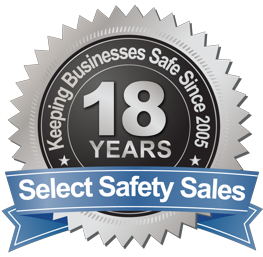
Eye Wash Station Maintenance: Why It’s So Important
October 20, 2023
OSHA’s InfoSheet on eye wash station maintenance, focuses in particular on the health effects of contaminated eye wash station water. Even a cursory reading leaves no doubt: infections arising from stagnant water can be nasty and dangerous—which is why eye wash station maintenance is so important.
Hazards Associated With Improper Eye Wash Station Maintenance
The biggest hazard associated with improperly maintained eye wash stations is infection. When water is stationary over time, it’s more likely to contain infection-causing organisms, such as Acanthamoeba, Pseudomonas and Legionella. When workers use eye wash stations with contaminated water, organisms can enter their body via the eye, skin or respiratory system.
Let’s look at each of these organisms in more detail.
Acanthamoeba
Acanthamoeba is a microscopic, free-living ameba (single-celled living organism) that can infect the eye’s cornea, which is called Acanthamoeba keratitis. Symptoms may include:
- Eye redness
- Blurred vision
- Pain
- Tearing
- Inflammation
- Light sensitivity.
While Acanthamoeba keratitis is most often results from improper cleaning and use of contact lenses, it can also be transmitted through stagnant eye wash station water, especially if the cornea has been injured.
Acanthamoeba can also lead to neurological infections or whole body infections, especially if the immune system is compromised.
Pseudomonas
Pseudomonas is a group of aerobic gammaproteobacteria that can cause infections of the eyes, skin, muscle, lung and other tissues. The most common infection-causing type is Pseudomonas aeruginosa. Symptoms of Pseudomonas aeruginosa eye infections are the same as Acanthamoeba keratitis (above). Diagnosis is typically made through blood samples. A Pseudomonas aeruginosa infection can travel through the blood stream, eventually causing fevers, chills, confusion, shock and even death if left untreated.
Legionella
Legionnella is a bacteria that can cause lung infections, including Pontiac Fever and Legionnaires’ disease. Symptoms can include:
- Coughing
- Shortness of breath
- Fever
- Muscle aches
- Headaches.
Legionella can be found in areas with warm water, such as hot tubs, hot water tanks and large plumbing systems. But it can also be found in improperly maintained eye wash stations.
Thankfully, most of these infections can be successfully treated with antibiotics if it’s diagnosed early, if it’s localized to the eye area and if the infected person is in good health. But for everyone’s protection, it’s better to prevent these infections from occurring through proper eye wash station maintenance.
Eye Wash Station Maintenance Procedures to Discourage Bacterial Growth
Methods to discourage the growth of harmful bacteria will vary for different types of stations. But generally, the two methods are regular flushing and use of anti-bacterial agents in the water solution.
Discouraging bacterial growth in plumbed eye wash stations
For OSHA compliance, employers should follow ANSI standard Z358.1-2014. The standard recommends weekly system flushing to clear lines of sediment and minimize microbial contamination. It’s important you flush all water-feeding lines, including hot and cold if applicable. For more specific guidance, consult the manufacturer instructions for your particular unit.
Discouraging bacterial growth in self-contained eye wash stations
The fluid in portable, self-contained eye wash stations contains chemical agents to control bacterial growth, but these are only effective for limited periods of time. It’s critical to follow manufacturers instructions and replace the solution before its expiry date.
Also, you should only refill or top up tanks with manufacturer recommended solutions. Because of issues with improper filling and cross-contamination, today many portable eye wash stations use only factory-sealed cartridges that can remain bacteria free for longer periods of time.
In House Maintenance or Contract Out?
Ideally, you should address the question of maintenance BEFORE purchasing eye wash station units because different kinds of units require different levels of maintenance.
Generally, plumbed units require more maintenance because you have to flush them regularly. But at the same time, you don’t need to purchase specialized solutions for them.
In contrast, you DO have to purchase special solutions for self-contained units, but you don’t have to perform weekly flushing maintenance.
For large industrial plants and manufacturing facilities, regular maintenance of multiple eye wash stations can be costly and time consuming. If your in house team doesn’t have the time or expertise to perform regular maintenance, you might want to hire an experienced and reputable outside contractor to do the work for you.
Eye Wash System Maintenance and Select Safety Sales
Select Safety Sales carries a wide variety of emergency eye wash stations, including plumbed and portable units from major manufacturers such as Speakman, Haws, Bradley and Encon. For over eighteen years, we’ve supplied emergency eye wash stations and emergency showers to almost every imaginable industry! And many of our eye wash stations ship for free.
If you’d like more information on the maintenance procedures of any of these units, don’t hesitate to contact our safety experts at (866) 864-3495 or email sales@selectsafetysales.com.
For more general information on eye wash stations, consult our buyer’s guide.





